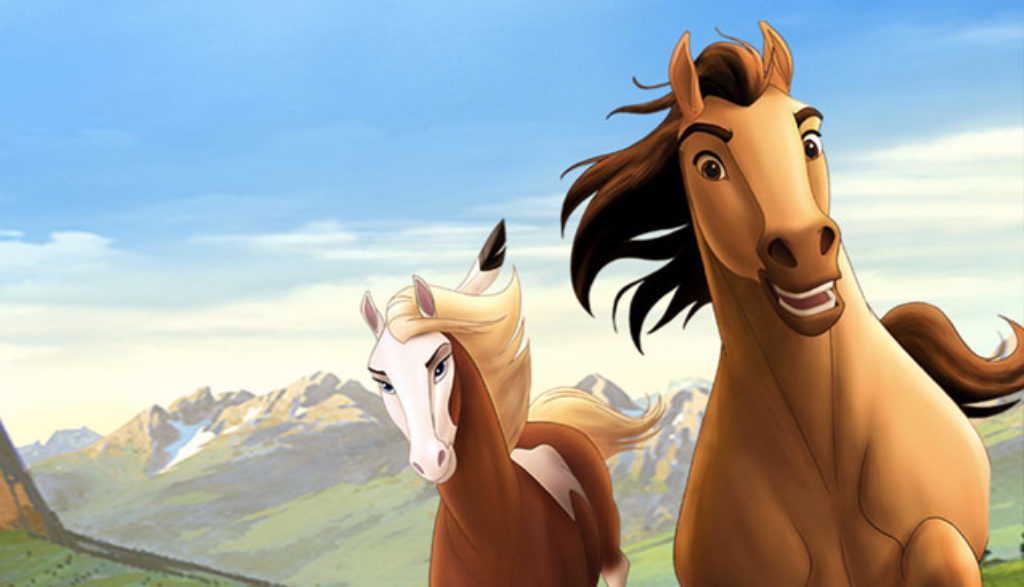
Before the railroads cut their way through the West, wild horses ran free. From the grasslands of Oklahoma, across the Rockies to the red arches of Utah the herds ranged, unbridled and unafraid. Spirit: Stallion of the Cimarron tells the story of the old West “from the heart of a horse.” Spirit is a strong mustang who eventually becomes the leader of his herd. As such, he protects his mother and the other horses from danger. But storms and mountain lions are nothing compared to a new kind of predator Spirit discovers one night in the hills. Drawn by the light of a campfire, the horse encounters a half-dozen sleeping men. Much to his surprise, the “two-leggeds” are vicious. They capture him, bind him and take him to a U.S. Army outpost, where an arrogant Colonel aims to make him one more notch on his horse-breaking belt. But the Colonel has never encountered the likes of this stallion who stubbornly withstands days without food and water, as well as the painful end of a riding crop. While in captivity, Spirit finds a kindred spirit in Little Creek, a Lakota brave who is captured by the Army and treated little better than the animals. Together the two escape and embark on a quest to save the West from the “civilized” intruders.
positive content: Spirit considers being the leader of his herd an honor and says, “with that honor came responsibility.” Repeatedly, he risks his life, safety or freedom for the sake of others. Playful and respectful interaction between Spirit and Little Creek shows reverence for nature and creation. Spirit’s undying determination presents a positive message about perseverance.
sexual content: Exploring the human camp for the first time, Spirit nuzzles a dreaming man who turns over, smiles in his sleep and kisses the horse.
violent content: Spirit defends the herd from a mountain lion in a scene that may be frightening for young viewers. While the first segment of the film is very tame, the second half is action-filled, with realistic catastrophes blending with cartoonish pandemonium. Spirit, refusing to be broken, throws multiple riders from his back. The Army, in return, does everything in its power to wear the horse down, starving him for days, lashing all of his limbs to posts and beating him. Men are kicked by horses. They in turn fire their guns, once hitting a horse (though no wound is shown). Horses fall down a waterfall. An empty steam train crashes down a mountain and starts an enormous fire.
crude or profane language: As the men try to capture and break Spirit, a couple of phrases, “Son of a . . .” and “What the h—?” are spoken, but cut off mid-thought. The latter expression is completed once, but it’s barely audible and will be missed by most viewers.
drug and alcohol content: One of the men around the campfire has a bottle (presumably liquor) next to his blankets. No alcohol consumption is shown.
other negative elements: While not precisely a “negative” event, the opening scene portrays Spirit’s mother giving birth. The portrayal isn’t unduly graphic, but it may disturb very young children who don’t understand her pained cries.
conclusion: Spirit’s animated rendition of the glories of the West is spectacular. Magnificent lightning storms. Rushing rivers. Soaring eagles. Another noteworthy innovation is that, though the story is told from Spirit’s perspective, none of the film’s animals talk (Matt Damon narrates in retrospect, but there’s no Mr. Ed action here). As a significant contribution to a new age of 2D animation, the movie is worth watching. But a line from the tale’s opening segment provides a telling insight into Spirit’s spirit. “Whether the West was won or lost, I’ll leave that up to you to decide.” It turns out to be the biggest rhetorical question ever, because the intended message is clear: White men bad; Indians and animals good. Industrial progress bad; nature good. Most teens and adults will see right through the thin plot, spin-heavy themes and overly manipulative Bryan Adams soundtrack. This is definitely a case in which being seven years old would have its advantages. Political correctness and revisionist history will soar over the heads of most adoring children, who will instead enjoy watching “all the pretty horses!”
